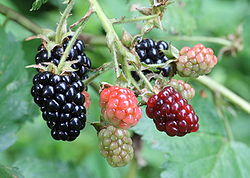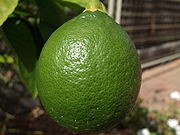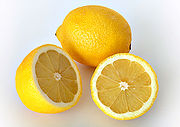
Ripening
Encyclopedia



Fruit
In broad terms, a fruit is a structure of a plant that contains its seeds.The term has different meanings dependent on context. In non-technical usage, such as food preparation, fruit normally means the fleshy seed-associated structures of certain plants that are sweet and edible in the raw state,...
s that causes them to become more palatable. In general, a fruit becomes sweeter
Sweetness
Sweetness is one of the five basic tastes and is almost universally regarded as a pleasurable experience. Foods rich in simple carbohydrates such as sugar are those most commonly associated with sweetness, although there are other natural and artificial compounds that are sweet at much lower...
, less green, and softer as it ripens. Even though the acidity of fruit increases as it ripens, the higher acidity level does not make the fruit seem tarter, which can lead to the misunderstanding that the riper the fruit the sweeter. This curious fact is attributed to the Brix
Brix
Degrees Brix is the sugar content of an aqueous solution.One degree Brix is 1 gram of sucrose in 100 grams of solution and represents the strength of the solution as percentage by weight . If the solution contains dissolved solids other than pure sucrose, then the °Bx is only approximate the...
-Acid Ratio.
Ripening agents
Ripening agents speed up the ripening process.They allow many fruits to be picked prior to full ripening, which is useful, since ripened fruits do not ship well. For example, banana
Banana
Banana is the common name for herbaceous plants of the genus Musa and for the fruit they produce. Bananas come in a variety of sizes and colors when ripe, including yellow, purple, and red....
s are picked when green and artificially ripened after shipment by being gassed with ethylene
Ethylene
Ethylene is a gaseous organic compound with the formula . It is the simplest alkene . Because it contains a carbon-carbon double bond, ethylene is classified as an unsaturated hydrocarbon. Ethylene is widely used in industry and is also a plant hormone...
. A similar method used in parts of Asia is to put a plastic cover over a bed of slightly green-harvested mangos and a few small open containers of clumps of calcium carbide
Calcium carbide
thumb|right|Calcium carbide.Calcium carbide is a chemical compound with the chemical formula of CaC2. The pure material is colorless, however pieces of technical grade calcium carbide are grey or brown and consist of only 80-85% of CaC2 . Because of presence of PH3, NH3, and H2S it has a...
. The moisture in the air reacts with the calcium carbide to release the gas acetylene
Acetylene
Acetylene is the chemical compound with the formula C2H2. It is a hydrocarbon and the simplest alkyne. This colorless gas is widely used as a fuel and a chemical building block. It is unstable in pure form and thus is usually handled as a solution.As an alkyne, acetylene is unsaturated because...
(ethyne), which has the same effect as ethylene. Ethylene is not emitted by the plant naturally, and cannot activate the ripening of nearby fruits, rather, it is used as a hormone within the plant.
Calcium carbide
Calcium carbide
thumb|right|Calcium carbide.Calcium carbide is a chemical compound with the chemical formula of CaC2. The pure material is colorless, however pieces of technical grade calcium carbide are grey or brown and consist of only 80-85% of CaC2 . Because of presence of PH3, NH3, and H2S it has a...
is used for ripening fruit artificially in some countries. Since industrial-grade calcium carbide may contain traces of arsenic and phosphorus, the use of this chemical for this purpose is illegal in most countries. Calcium carbide, once dissolved in water, produces acetylene, which acts as an artificial ripening agent. Acetylene
Acetylene
Acetylene is the chemical compound with the formula C2H2. It is a hydrocarbon and the simplest alkyne. This colorless gas is widely used as a fuel and a chemical building block. It is unstable in pure form and thus is usually handled as a solution.As an alkyne, acetylene is unsaturated because...
is believed to affect the nervous system
Nervous system
The nervous system is an organ system containing a network of specialized cells called neurons that coordinate the actions of an animal and transmit signals between different parts of its body. In most animals the nervous system consists of two parts, central and peripheral. The central nervous...
by reducing the oxygen
Oxygen
Oxygen is the element with atomic number 8 and represented by the symbol O. Its name derives from the Greek roots ὀξύς and -γενής , because at the time of naming, it was mistakenly thought that all acids required oxygen in their composition...
supply to the brain
Brain
The brain is the center of the nervous system in all vertebrate and most invertebrate animals—only a few primitive invertebrates such as sponges, jellyfish, sea squirts and starfishes do not have one. It is located in the head, usually close to primary sensory apparatus such as vision, hearing,...
. Agricultural industry PR claims that acetylene is not sufficiently reactive to affect consumers.
Catalytic generators are used to produce ethylene gas simply and safely. Ethylene sensors can be used to precisely control the amount of gas.
Covered fruit ripening bowls are commercially available. The manufacturers claim the bowls increase the amount of ethylene and carbon dioxide gases around the fruit, which promotes ripening.
Climacteric fruits
Climacteric fruits
Climacteric fruits refer to fruits that have high respiration rate during the fruit's ripening. During the ripening process of climacteric fruits, the production of a phytohormone, ethylene, dramatically increase up to 1000-fold of the basal ethylene level.Climacteric fruits are ones that are able...
are able to continue ripening after being picked, a process accelerated by ethylene
Ethylene
Ethylene is a gaseous organic compound with the formula . It is the simplest alkene . Because it contains a carbon-carbon double bond, ethylene is classified as an unsaturated hydrocarbon. Ethylene is widely used in industry and is also a plant hormone...
gas. Non-climacteric fruits can ripen only on the plant and thus have a short shelf life if harvested when they are ripe.
Delaying ripening
SmartFreshSmartFresh
SmartFresh is a brand of a synthetic produce quality enhancer based on 1-methylcyclopropene . It is marketed by AgroFresh Inc.-Function:...
is a technology useful for maintaining the fresh-picked quality of whole fruits and vegetables. 1-Methylcyclopropene
1-Methylcyclopropene
1-Methylcyclopropene is a cyclopropene derivative used as a synthetic plant growth regulator. It is structurally related to the natural plant hormone ethylene and it is used commercially to slow down the ripening of fruit and to help maintain the freshness of cut flowers.-Chemical...
(1-MCP 0.14%) works with the ripening process to dramatically slow down ethylene production and prevent over-ripening and problems associated with aging.
Ripening indicators
IodineIodine
Iodine is a chemical element with the symbol I and atomic number 53. The name is pronounced , , or . The name is from the , meaning violet or purple, due to the color of elemental iodine vapor....
(I) can be used to determine whether fruit is ripening or rotting by showing whether the starch
Starch
Starch or amylum is a carbohydrate consisting of a large number of glucose units joined together by glycosidic bonds. This polysaccharide is produced by all green plants as an energy store...
in the fruit has turned into sugar
Sugar
Sugar is a class of edible crystalline carbohydrates, mainly sucrose, lactose, and fructose, characterized by a sweet flavor.Sucrose in its refined form primarily comes from sugar cane and sugar beet...
. For example, a drop of iodine on a slightly rotten part (not the skin) of an apple will turn a dark-blue or black color, since starch is present. If the iodine is applied and takes 2-3 seconds to turn blue/black, then the process has begun but is not yet complete. If the iodine stays yellow, then most of the starch has been converted to sugar.
External links
- http://web.archive.org/web/20070927121733/http://plantphys.info/plants_human/fruitgrowripe.html
- http://www.actahort.org/books/398/398_17.htm

